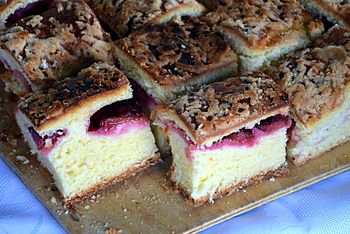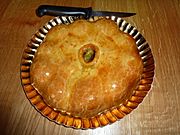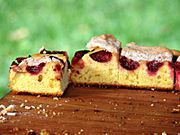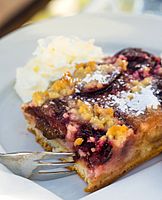Plum cake facts for kids
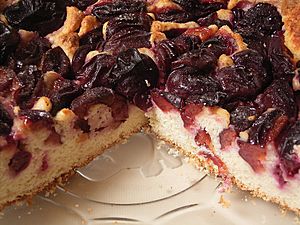
A plum cake with plums baked inside and atop the cake
|
|
| Type | Cake |
|---|---|
| Course | Dessert |
| Serving temperature | Cold or warmed |
| Main ingredients | currants, raisins, or prune fruit and cake batter |
| Similar dishes | Fruitcake |
Plum cake is a type of cake that can be made in two main ways. Some plum cakes use dried fruits like currants, raisins, or prunes. Other plum cakes use fresh plums.
For a long time, the word "plum" meant different things. In England, many cakes called "plum cake" since the 1700s are now known as fruitcake. This is because "plum" used to mean any dried fruit. English plum cakes were brought to British colonies, like India and America. In India, they became popular around Christmas. In America, one type was even called "election cake" because it was served during elections.
Other kinds of plum cakes use fresh plums as a main ingredient. These cakes came from different traditions. Sometimes, the plums turn into a jam-like filling inside the cake. Plum cake with fresh plums is also part of Ashkenazi Jewish cooking. It is known as Pflaumenkuchen or Zwetschgenkuchen. You can also find plum-based cakes in French, Italian, and Polish cooking.
Contents
What is Plum Cake?
The Meaning of "Plum" in Cakes
The words "plum cake" and "fruit cake" are often used to mean the same thing. This is because "plum" used to describe any dried fruit used to sweeten cakes. So, many old "plum cakes" and "plum puddings" do not contain the fresh plum fruit we know today.
For example, Plum pudding is a rich dish made with similar dried fruits. It is cooked by steaming instead of baking. The "plums" in these puddings were always raisins, not fresh, juicy plums. The word "plum" originally referred to dried fruits like prunes, raisins, or grapes.
In old English, the word plūme came from a Latin word meaning "prune." In modern French, prune means plum. So, French plum tarts are called tarte aux prunes. When modern cakes use dried plums (prunes) as a main ingredient, they might still be called a plum cake.
Plum Cake Around the World
Britain's Fruitcake Connection
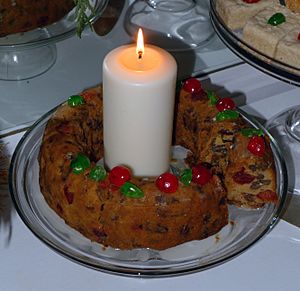
In England, "plum cake" has meant a type of fruitcake since about 1700. These cakes used raisins and currants. These dried fruits were called "plums" in English around 1660. Getting these dried fruits used to be a lot of work. They came from places like the Levant and the Mediterranean.
In 1881, someone said that "a good English plum cake...is a national institution." This shows how important it was. Famous writer Thomas Carlyle enjoyed a light plum cake with tea. He would dip the cake, which he said was like a bun with currants.
Plum cakes were made light and fluffy by whipping air into the cake batter. They did not use yeast. Many recipes for plum cakes and puddings were in the popular Mrs Beeton's Book of Household Management (published 1859-1861) by Isabella Beeton. Her book included recipes for "A Common Plum Cake" and "Christmas Plum-Pudding."
Before World War I, cakes like plum cakes were often baked at the same time as loaves of bread. Large plum cakes would take about the same time to bake as bread.
European Plum Cakes
The English style of plum cake is also found in Europe. However, in Europe, "plum cake" usually means cakes made with fresh fruit.
French Plum Cakes
In French cooking, plums are very important for cakes. In regions like the Loire and the Dordogne, plum or mirabelle tarts were often served at celebrations. These tarts could use fresh plums, dried plums, or plum jam, depending on the season. The Mirabelle plum is a special kind of plum used to make Tarte aux mirabelles. A Galette aux fruits is another type of French cake. It is made with yeast dough and topped with cooked seasonal fruits, like plums.
German Plum Cakes
The German plum cake is called Zwetschkenkuchen. You can find it all over Germany, but it is especially popular in Bavaria. Chef Robert Carrier's recipe for this cake uses a yeast pastry base. This helps the cake soak up the plum juice without getting soggy.
Italian and Polish Plum Cakes
In Italy, plum cake is known by its English name. It is baked with dried fruit and often includes yogurt. The Polish version of plum cake uses fresh fruit. It is called Placek z Sliwkami.
-
Sanok-style plum cake, Poland
-
Zwetschkenkuchen, Tirol, Austria
Indian Plum Cakes
In India, plum cake is often served around the Christmas holiday season. Sometimes, extra ingredients like rum are added for flavor.
United States Plum Cakes
Plum cake in the United States started with English settlers. They made it in the English style. These cakes were made for parties, like for Twelfth Night and Christmas. They were also made in large sizes for weddings. This original fruitcake version of plum cake was a very popular "celebration cake" in America until the Civil War.
Election Cakes
During colonial times, before the American Revolution, "Muster" cakes were baked for men called to military training. After the American Revolution, women baked many of these cakes. They wanted to encourage men to attend town meetings and elections. So, the cake became known as "election cake."
Election cake was made with currants, raisins, molasses, and spices. Later, brandy was sometimes added to the recipe. These cakes were usually made with yeast to help them rise. In New England, large election cakes, weighing about 12 pounds, were traditionally served while people waited for election results. The first recipe for election cake was published in 1796 in a book called American Cookery.
Early cookbooks in the Southern United States also had plum cake recipes in the fruitcake style. These recipes did not actually call for fresh plums. After 1830, plum cake was often called fruit cake or black cake. In 1885, a description of plum cake sounded like plum pudding. It was described as a thick, dark cake with lots of plums and a gritty texture from raisins.


